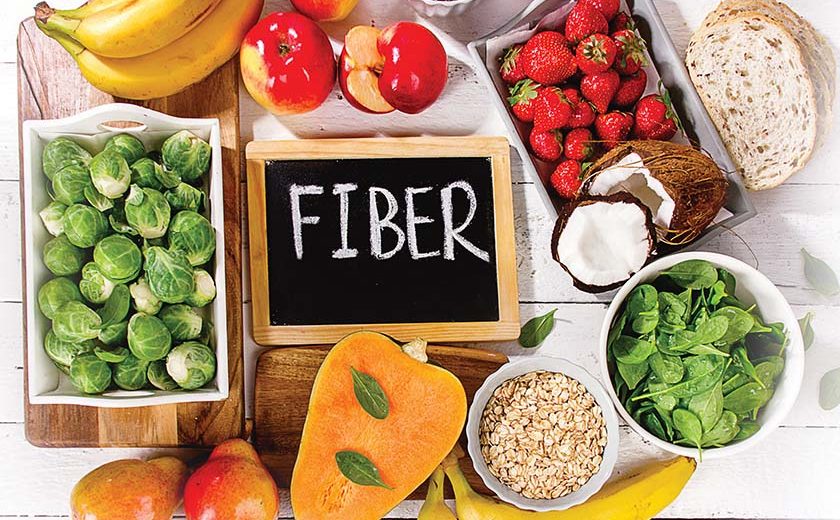Many of us associate fibre with digestive health and bodily functions we’d rather not think about. However, eating foods high in dietary fibre can do so much more than keep you regular.
It can lower your risk for heart disease, stroke, and diabetes, improve the health of your skin, and help you lose weight. It may even help prevent colon cancer. However, most of us aren’t eating nearly enough. By using these tips to add more fibre to your diet, you can help prevent serious diseaseand look and feel your best.
What is fibre?
Fibre, also known as roughage, is the part of plant-based foods (grains, fruits, vegetables, nuts, and beans) that the body can’t break down. It passes through the body undigested, keeping your digestive system clean and healthy, easing bowel movements, and flushing cholesterol and harmful carcinogens out of the body.
Fibre comes in two varieties: insoluble and soluble
Insoluble fibre does not dissolve in water. It is the bulky fibre that helps to prevent constipation, and is found in whole grains, wheat cereals, and vegetables such as carrots, celery, and tomatoes.
Soluble fibre dissolves in water and helps control blood sugar levels and reduce cholesterol. Good sources include barley, oatmeal, beans, nuts, and fruits such as apples, berries, citrus fruits, and pears.
Many foods contain both soluble and insoluble fibre. In general, the more natural and unprocessed the food, the higher it is in fibre. There is no fibre in meat, dairy, or sugar. Refined or “white” foods, such as white bread, white rice, and pastries, have had all or most of their fibre removed.
The health benefits of fibre
The latest figures show that many people around the world are not eating enough fibre. Part of the problem may be due to the association between fibre and bathroom habits. Yes, fibre offers a healthy and effective way to stay regular. But that’s not the only reason why we should be including more in our diets. Many different studies have highlighted how eating a diet high in fibre can boost your immune system and overall health, and improve how you look and feel.
Some of the benefits include:
Digestive health. Let’s get this one out of the way first. Dietary fibre normalises bowel movements by bulking up stools and making them easier to pass. This can help relieve and prevent both constipation and diarrhoea. Eating plenty of fibre can also reduce your risk for diverticulitis (inflammation of the intestine), hemorrhoids, gallstones, kidney stones, and provide some relief for irritable bowel syndrome (IBS). Some studies have also indicated that a high-fibre diet may help to lower gastric acid and reduce your risk for gastroesophageal reflux disorder (GERD) and ulcers.
Heart disease. Fibre, particularly soluble fibre, is an important element of any heart-healthy diet. Eating a diet high in fibre can improve cholesterol levels by lowering LDL (bad) cholesterol. A high fibre intake can also reduce your risk for metabolic syndrome, a group of risk factors linked to coronary heart disease, diabetes, and stroke. Fibre can also help to lower blood pressure, reduce inflammation, improve levels of HDL (good) cholesterol, and shed excess weight around the abdomen.
Diabetes. A diet high in fibre – particularly insoluble fibre from cereals – can lower your risk for type 2 diabetes. If you already have diabetes, eating soluble fibre can slow the absorption of sugar and improve your blood
sugar levels.
Cancer. There is some research that suggests eating a high-fibre diet can help prevent colorectal cancer, although the evidence is not yet conclusive. Diets rich in high-fibre foods are also linked to a lower risk for other common digestive system cancers, including stomach, mouth, and pharynx.
Skin health. When yeast and fungus are excreted through the skin, they can trigger outbreaks or acne. Eating fibre, especially psyllium husk (a type of plant seed), can flush toxins out of your body, improving the health and appearance of your skin.
Fibre and weight loss
As well as aiding digestion and preventing constipation, fibre adds bulk to your diet, a key factor in both losing weight and maintaining a healthy weight. Adding bulk can help you feel full sooner. Since fibre stays in the stomach longer than other foods, that feeling of fullness will stay with you much longer, helping you to eat less. High-fibre foods such as fruits and vegetables tend to be low in calories, so by adding fibre to your diet, it’s easier to cut calories. There are other ways that a high fibre intake can aid weight loss:
- By regulating your blood sugar levels, fibre can help maintain your body’s fat-burning capacity and avoid insulin spikes that leave you feeling drained and craving unhealthy foods.
- Eating plenty of fibre can move fat through your digestive system at a faster rate so that less of it can be absorbed.
- When you fill up on high-fibre foods such as fruit, you’ll also have more energy for exercising.
- By regulating your blood sugar levels, it can help maintain your body’s fat-burning capacity and avoid insulin spikes that leave you feeling drained and craving unhealthy foods. Eating plenty of fibre can also move fat through your digestive system at a faster rate so that less of it can be absorbed.
- And when you fill up on high-fibre foods such as fruit, you’ll also have more energy for exercising.
Boosting your fibre to be sure you get the recommended daily intake may lower your risk for developing chronic diseases, according to the Academy of Nutrition and Dietetics. Getting extra fibre with your morning juice or while enjoying a midday fruit drink would be great, but you won’t get much fibre unless you purchase a fortified beverage.


